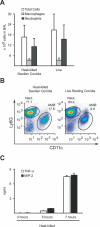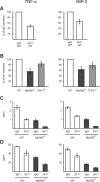Aspergillus fumigatus triggers inflammatory responses by stage-specific beta-glucan display
- PMID: 16304610
- PMCID: PMC1287910
- DOI: 10.1371/journal.ppat.0010030
Aspergillus fumigatus triggers inflammatory responses by stage-specific beta-glucan display
Abstract
Inhalation of fungal spores (conidia) occurs commonly and, in specific circumstances, can result in invasive disease. We investigated the murine inflammatory response to conidia of Aspergillus fumigatus, the most common invasive mold in immunocompromised hosts. In contrast to dormant spores, germinating conidia induce neutrophil recruitment to the airways and TNF-alpha/MIP-2 secretion by alveolar macrophages. Fungal beta-glucans act as a trigger for the induction of these inflammatory responses through their time-dependent exposure on the surface of germinating conidia. Dectin-1, an innate immune receptor that recognizes fungal beta-glucans, is recruited in vivo to alveolar macrophage phagosomes that have internalized conidia with exposed beta-glucans. Antibody-mediated blockade of Dectin-1 partially inhibits TNF-alpha/MIP-2 induction by metabolically active conidia. TLR-2- and MyD88-mediated signals provide an additive contribution to macrophage activation by germinating conidia. Selective responsiveness to germinating conidia provides the innate immune system with a mechanism to restrict inflammatory responses to metabolically active, potentially invasive fungal spores.
Conflict of interest statement
Figures





References
-
- Janeway CA, Jr, Medzhitov R. Innate immune recognition. Annu Rev Immunol. 2002;20:197–216. - PubMed
-
- Beutler B. Innate immunity: An overview. Mol Immunol. 2004;40:845–859. - PubMed
-
- Akira S, Takeda K. Toll-like receptor signalling. Nat Rev Immunol. 2004;4:499–511. - PubMed
-
- Schaffner A, Douglas H, Braude A. Selective protection against conidia by mononuclear and against mycelia by polymorphonuclear phagocytes in resistance to Aspergillus. Observations on these two lines of defense in vivo and in vitro with human and mouse phagocytes. J Clin Invest. 1982;69:617–631. - PMC - PubMed
Publication types
MeSH terms
Substances
Grants and funding
LinkOut - more resources
Full Text Sources
Other Literature Sources
Medical

